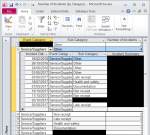Hi
I have a database which records 'incidents' (ie things going wrong in my place of work).
I have created a totals query (based on a single table) which shows how many incidents have been recorded for each category of incident (eg IT, suppliers, on call etc) in my database.
I want to add a subdatasheet so that clicking the little plus sign will give more details about the incidents in that category.
In properties, I have added the table's name under 'Subdatasheet Name' and added 'Incident ID' (the table's primary key) under both 'Link Child Fields' and 'Link Master Fields'.
However, when I run the query and click the little plus (to expand, for example, incidents in the 'IT' category), I just get a pop up saying 'Enter parameter value Incident ID'.
Can anyone advise how to solve this so that I can see the details of the incidents in the subdatasheet?
Many thanks in advance.
I have a database which records 'incidents' (ie things going wrong in my place of work).
I have created a totals query (based on a single table) which shows how many incidents have been recorded for each category of incident (eg IT, suppliers, on call etc) in my database.
I want to add a subdatasheet so that clicking the little plus sign will give more details about the incidents in that category.
In properties, I have added the table's name under 'Subdatasheet Name' and added 'Incident ID' (the table's primary key) under both 'Link Child Fields' and 'Link Master Fields'.
However, when I run the query and click the little plus (to expand, for example, incidents in the 'IT' category), I just get a pop up saying 'Enter parameter value Incident ID'.
Can anyone advise how to solve this so that I can see the details of the incidents in the subdatasheet?
Many thanks in advance.


